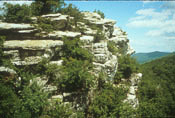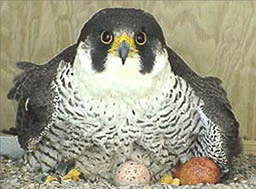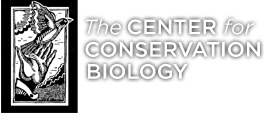NESTING SUBSTRATE

Hawksbill, Shenandoah National Park, VA
Historically, peregrine falcons in Virginia nested primarily in the mountains on shear cliff faces. Nesting activities occurred on a shelf or ledge within the cliff. All known pairs in the state now nest on artificial structures such as bridges, towers, and isolated shacks.
Unlike many other raptors, peregrines do not build stick nests but require appropriate substrate to make a scrape or depression to hold the eggs. Peregrines nesting on natural ledges made scrapes in dirt, gravel and debris that built up over time on these structures. Small pea gravel is made available within current nest boxes to provide pairs with substrate to form nest scrapes.
COURTSHIP
In Virginia, at least a portion of the population remains on their breeding territories year round. Courtship serves to strengthen the pair bond and brings the pair into reproductive synchrony. Courtship behaviors may be seen in Virginia over a long time period depending on the breeding chronology of the specific pair but is typically observed most intensively during the month of March. Courtship involves several behaviors performed in flight or in the vicinity of the nest site. These include circling flights, bows, and displays. Behaviors are often associated with vocalizations. During the courtship period, the male will frequently offer prey to the female.
EGGS

Eggs vary in color from a rich, mottled reddish-brown to a more pale creamy brown.In Virginia, typical clutches vary from 3 to 5 with 4 being the most common. Female lays eggs at 2 to 3 day intervals until clutch is complete. Eggs are incubated by both members of the pair and typically hatch between 31 and 35 days.
EYASES

When young falcons hatch they weigh about 1 1/2 ounces (1/8 pound) and are nearly naked. They develop quickly and become covered with a dense coat of white down. This down is replaced by contour and flight feathers over a 3 to 5 week period. By 6 weeks they are full grown and feathered. Males develop faster than females since they achieve a smaller adult size. Chicks begin to fly when about 40 to 45 days old. As they become more experienced on the wing they begin to learn to hunt on their own. In Virginia, young birds begin to disperse from their natal sites in September and October.


DIET

A peregrine falcon scans the flock of semipalmated plovers and western sandpipers. Photo by Bart Paxton.
Peregrine falcons specialize on avian prey. They are extraordinarily agile and fast on the wing. They kill other birds by stooping at high speed, striking with partially closed feet, and catching them in midair as they fall to the ground. They are also capable of overtaking prey in level flight and grabbing them from the air. Peregrine diet varies with season and location. In coastal Virginia, they feed a great deal on shorebirds during spring and fall. In urban areas, they feed on pigeons, grackles, blue jays and other medium-sized birds. Peregrines take birds of varying size from small passerines to larger ducks and other waterbirds.
